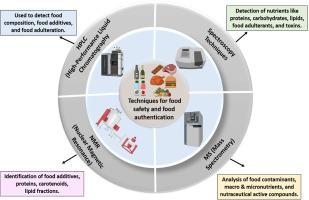Progressive analytical techniques utilized for the detection of contaminants attributed to food safety and security
IF 4.1
Q1 CHEMISTRY, ANALYTICAL
引用次数: 0
Abstract
Food analysis and authentication are very crucial to assure safety, quality, and integrity of food and food-related products. Analysis of food products not only ensures the quality of food but also gives information about composition, physical characteristics, flavor, shelf-life, safety, microstructure, and processibility. Consequently, food is now regarded as an inexpensive means of preventing disease while also serving as a source of energy. Typically, a wide range of distinct chemical components make up the chemical composition of food. Furthermore, during processing or storage, food is always susceptible to structural alterations. Therefore, to assess the nutritional value and the quality of food products, food components must be analyzed and quantified. Food analysis mainly includes the preparation, examination, and identification of major food components, such as dietary fiber, phenolic compounds, carbohydrates, proteins, amino acids, peptides, enzymes, phospholipids, pesticides, alcohols, fat-soluble and water-soluble vitamins, organic acids, organic bases, bittering agents, pigments, and aroma compounds, as well as minor components including preservatives, antioxidants, colorants. Therefore, there are several advanced analytical techniques, including spectroscopy, mass spectrometry, chromatography, NMR, HSI, MALDI-TOF, RT-PCR, biosensors, etc. have been vital in the food science domain due to their high selectivity and sensitivity. This review emphasizes implementing various analytical techniques to analyze food safety and security.

用于检测食品安全污染物的先进分析技术
食品分析和鉴定对于确保食品和食品相关产品的安全、质量和完整性至关重要。食品分析不仅能确保食品质量,还能提供有关成分、物理特性、风味、保质期、安全性、微观结构和加工性等方面的信息。因此,食品现在被视为一种预防疾病的廉价手段,同时也是一种能量来源。食品的化学成分通常由多种不同的化学成分组成。此外,在加工或储存过程中,食品的结构总是容易发生变化。因此,为了评估食品的营养价值和质量,必须对食品成分进行分析和量化。食品分析主要包括膳食纤维、酚类化合物、碳水化合物、蛋白质、氨基酸、肽、酶、磷脂、杀虫剂、醇类、脂溶性和水溶性维生素、有机酸、有机碱、苦味剂、色素和芳香化合物等主要食品成分,以及防腐剂、抗氧化剂、着色剂等次要成分的制备、检验和鉴定。因此,一些先进的分析技术,包括光谱、质谱、色谱、核磁共振、HSI、MALDI-TOF、RT-PCR、生物传感器等,因其高选择性和高灵敏度而在食品科学领域发挥着重要作用。本综述强调采用各种分析技术来分析食品安全和保障。
本文章由计算机程序翻译,如有差异,请以英文原文为准。
求助全文
约1分钟内获得全文
求助全文

 求助内容:
求助内容: 应助结果提醒方式:
应助结果提醒方式:


